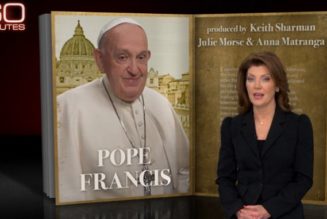
> Italiano
> English
> Español
> Français
> All the articles of Settimo Cielo in English
*
Benedict XVI promoted him to apostolic nuncio in the United States in 2011. The meek theologian pope certainly could not have imagined, nine years ago, that Archbishop Carlo Maria Viganò – who returned to private life in 2016 but has been anything but hidden – would today be blaming him for having “deceived” the whole Church in that he would have it be believed that the Second Vatican Council was immune to heresies and moreover should be interpreted in perfect continuity with true perennial doctrine.
Because this is just the length to which Viganò has gone in recent days, capping off a relentless barrage of denunciations of Church heresies over the last few decades, with the root of it all being the Council, most recently in an exchange with Phil Lawler, editor of CatholicCulture.org.
Attention: not the Council interpreted badly, but the Council as such and en bloc. In his latest public statements, in fact, Viganò has rejected as too timid and vacuous even the claim of some to “correct” Vatican II here and there, in its texts which in his judgment are more blatantly heretical, such as the declaration “Dignitatis Humanae” on religious freedom. Because what must be done once and for all – he has demanded – is “to drop it ‘in toto’ and forget it.”
Naturally with the concomitant “expulsion from the sacred precinct” of all those Church authorities who, identified as guilty of the deception and “invited to amend,” have not changed their ways.
According to Viganò, what has distorted the Church ever since the Council is a sort of “universal religion whose first theoretician was Freemasonry.” And whose political arm is that “completely out-of-control world government” pursued by the “nameless and faceless” powers that are now bending to their own interests even the coronavirus pandemic.
Last May 8, cardinals Gerhard Müller and Joseph Zen Zekiun also carelessly affixed their signatures to an appeal by Viganò against this looming “New World Order.”
Just as to a subsequent open letter from Viganò to Donald Trump – whom he invoked as a warrior of light against the power of darkness that acts both in the “deep state” and in the “deep Church” – the president of the United States replied enthusiastically, with a tweet that went viral.
But getting back to the reckless indictment launched by Viganò against Benedict XVI for his “failed attempts to correct conciliar excesses by invoking the hermeneutic of continuity,” it is obligatory to give the accused the right to speak.
The hermeneutic of continuity – or more precisely: “the ‘hermeneutic of reform,’ of renewal in the continuity of the one subject-Church” – is in fact the keystone of the interpretation that Benedict XVI gave of Vatican Council II, in his memorable address to the Vatican curia on Christmas Eve of 2005, the first year of his pontificate.
It is a speech that is absolutely to be reread in its entirety:
> “Your Eminences, venerable brothers…”
But here in summation is how pope Joseph Ratzinger developed his exegesis of Vatican Council II.
He began by recalling that also after the Council of Nicaea in 325 the Church was rocked by the most heated conflicts, which made St. Basil write:
“The raucous shouting of those who through disagreement rise up against one another, the incomprehensible chatter, the confused din of uninterrupted clamouring, has now filled almost the whole of the Church, falsifying through excess or failure the right doctrine of the faith…”
But why has the aftermath of Vatican II been so contentious as well? Benedict XVI’s answer is that everything has depended “on its hermeneutic,” meaning on the “key to interpreting and applying it.”
The conflict has arisen from the fact that “two contrary hermeneutics came face to face and quarrelled with each other. ”
On the one hand there was a “hermeneutic of discontinuity and rupture.” On the other, a “hermeneutic of reform, of renewal in the continuity of the one subject-Church.”
According to the first hermeneutic “it would be necessary not to follow the texts of the Council but its spirit,” making room for “impulses toward the new” that are seen as underlying the texts, “in which, to reach unanimity, it was found necessary to keep and reconfirm many old things that are now pointless.”
But with this – the pope objected – “the nature of a Council as such is therefore basically misunderstood. In this way, it is considered as a sort of constituent that eliminates an old constitution and creates a new one.” When instead “the essential constitution of the Church comes from the Lord” and the bishops need simply be its faithful and wise “administrators.”
Up to this point, Benedict XVI therefore seemed to attribute the hermeneutic of discontinuity to the Church’s progressive current alone. But further on in the address, in analyzing in depth the Council’s intention to “give a new definition to the relationship between the Church and the modern State,” he took up the question on which not the progressives but the traditionalists have stumbled more, to the point of breaking with the Church as the followers of Marcel Lefebvre have done and as Viganò now seems on the point of doing.
It is the question of religious freedom, addressed by the conciliar declaration “Dignitatis Humanae.” A declaration that Viganò too charges with the worst of offenses, to the point of writing that “if it has been possible for Pachamama to be worshiped in a church, we owe this to ‘Dignitatis Humanae’.”
In fact, it is undeniable that on religious freedom Vatican II marked a clear discontinuity, if not a rupture, with the ordinary teaching of the Church of the nineteenth and early twentieth centuries, which was strongly anti-liberal. Benedict XVI explicitly recognized this in his address and also explained the historical reasons for it, which precisely because they are historical have changed over time and allowed the Council, “recognizing and making its own an essential principle of the modern State with the Decree on Religious Freedom,” to recover “the deepest patrimony of the Church,” that “of Jesus himself” and “of the martyrs of the early Church,” who “died for freedom of conscience and the freedom to profess one’s own faith – a profession that no State can impose but which, instead, can only be claimed with God’s grace in freedom of conscience.”
“It is precisely in this combination of continuity and discontinuity at different levels that the very nature of true reform,” pope Ratzinger said in that address. “The Second Vatican Council, with its new definition of the relationship between the faith of the Church and certain essential elements of modern thought, has reviewed or even corrected certain historical decisions, but in this apparent discontinuity it has actually preserved and deepened her inmost nature and true identity.”
There is therefore a “hermeneutic of discontinuity” to which Benedict XVI as well gave his approval, because “it is precisely in this combination of continuity and discontinuity at different levels that the very nature of true reform consists.”
But at this point we might as well let him talk and reproduce below the final part of that address of his on the Council, in which he presented at length what has been summarized above in a few lines.
Viganò’s counterarguments are also available on the websites that cover him. Let the reader compare.
*
“In this process of innovation in continuity…”
by Benedict XVI
[…] In the great dispute about man which marks the modern epoch, the Council had to focus in particular on the theme of anthropology. It had to question the relationship between the Church and her faith on the one hand, and man and the contemporary world on the other. The question becomes even clearer if, instead of the generic term “contemporary world”, we opt for another that is more precise: the Council had to determine in a new way the relationship between the Church and the modern era.
This relationship had a somewhat stormy beginning with the Galileo case. It was then totally interrupted when Kant described “religion within pure reason” and when, in the radical phase of the French Revolution, an image of the State and the human being that practically no longer wanted to allow the Church any room was disseminated.
In the 19th century under Pius IX, the clash between the Church’s faith and a radical liberalism and the natural sciences, which also claimed to embrace with their knowledge the whole of reality to its limit, stubbornly proposing to make the “hypothesis of God” superfluous, had elicited from the Church a bitter and radical condemnation of this spirit of the modern age. Thus, it seemed that there was no longer any milieu open to a positive and fruitful understanding, and the rejection by those who felt they were the representatives of the modern era was also drastic.
In the meantime, however, the modern age had also experienced developments. People came to realize that the American Revolution was offering a model of a modern State that differed from the theoretical model with radical tendencies that had emerged during the second phase of the French Revolution.
The natural sciences were beginning to reflect more and more clearly their own limitations imposed by their own method, which, despite achieving great things, was nevertheless unable to grasp the global nature of reality.
So it was that both parties were gradually beginning to open up to each other. In the period between the two World Wars and especially after the Second World War, Catholic statesmen demonstrated that a modern secular State could exist that was not neutral regarding values but alive, drawing from the great ethical sources opened by Christianity.
Catholic social doctrine, as it gradually developed, became an important model between radical liberalism and the Marxist theory of the State. The natural sciences, which without reservation professed a method of their own to which God was barred access, realized ever more clearly that this method did not include the whole of reality. Hence, they once again opened their doors to God, knowing that reality is greater than the naturalistic method and all that it can encompass.
It might be said that three circles of questions had formed which then, at the time of the Second Vatican Council, were expecting an answer.
First of all, the relationship between faith and modern science had to be redefined. Furthermore, this did not only concern the natural sciences but also historical science for, in a certain school, the historical-critical method claimed to have the last word on the interpretation of the Bible and, demanding total exclusivity for its interpretation of Sacred Scripture, was opposed to important points in the interpretation elaborated by the faith of the Church.
Secondly, it was necessary to give a new definition to the relationship between the Church and the modern State that would make room impartially for citizens of various religions and ideologies, merely assuming responsibility for an orderly and tolerant coexistence among them and for the freedom to practise their own religion.
Thirdly, linked more generally to this was the problem of religious tolerance – a question that required a new definition of the relationship between the Christian faith and the world religions. In particular, before the recent crimes of the Nazi regime and, in general, with a retrospective look at a long and difficult history, it was necessary to evaluate and define in a new way the relationship between the Church and the faith of Israel.
These are all subjects of great importance – they were the great themes of the second part of the Council – on which it is impossible to reflect more broadly in this context. It is clear that in all these sectors, which all together form a single problem, some kind of discontinuity might emerge. Indeed, a discontinuity had been revealed but in which, after the various distinctions between concrete historical situations and their requirements had been made, the continuity of principles proved not to have been abandoned. It is easy to miss this fact at a first glance.
It is precisely in this combination of continuity and discontinuity at different levels that the very nature of true reform consists. In this process of innovation in continuity we must learn to understand more practically than before that the Church’s decisions on contingent matters – for example, certain practical forms of liberalism or a free interpretation of the Bible – should necessarily be contingent themselves, precisely because they refer to a specific reality that is changeable in itself. It was necessary to learn to recognize that in these decisions it is only the principles that express the permanent aspect, since they remain as an undercurrent, motivating decisions from within.
On the other hand, not so permanent are the practical forms that depend on the historical situation and are therefore subject to change.
Basic decisions, therefore, continue to be well-grounded, whereas the way they are applied to new contexts can change. Thus, for example, if religious freedom were to be considered an expression of the human inability to discover the truth and thus become a canonization of relativism, then this social and historical necessity is raised inappropriately to the metaphysical level and thus stripped of its true meaning. Consequently, it cannot be accepted by those who believe that the human person is capable of knowing the truth about God and, on the basis of the inner dignity of the truth, is bound to this knowledge.
It is quite different, on the other hand, to perceive religious freedom as a need that derives from human coexistence, or indeed, as an intrinsic consequence of the truth that cannot be externally imposed but that the person must adopt only through the process of conviction.
The Second Vatican Council, recognizing and making its own an essential principle of the modern State with the Decree on Religious Freedom, has recovered the deepest patrimony of the Church. By so doing she can be conscious of being in full harmony with the teaching of Jesus himself (cf. Mt 22: 21), as well as with the Church of the martyrs of all time. The ancient Church naturally prayed for the emperors and political leaders out of duty (cf. I Tm 2: 2); but while she prayed for the emperors, she refused to worship them and thereby clearly rejected the religion of the State.
The martyrs of the early Church died for their faith in that God who was revealed in Jesus Christ, and for this very reason they also died for freedom of conscience and the freedom to profess one’s own faith – a profession that no State can impose but which, instead, can only be claimed with God’s grace in freedom of conscience. A missionary Church known for proclaiming her message to all peoples must necessarily work for the freedom of the faith. She desires to transmit the gift of the truth that exists for one and all.
At the same time, she assures peoples and their Governments that she does not wish to destroy their identity and culture by doing so, but to give them, on the contrary, a response which, in their innermost depths, they are waiting for – a response with which the multiplicity of cultures is not lost but instead unity between men and women increases and thus also peace between peoples.
The Second Vatican Council, with its new definition of the relationship between the faith of the Church and certain essential elements of modern thought, has reviewed or even corrected certain historical decisions, but in this apparent discontinuity it has actually preserved and deepened her inmost nature and true identity.
The Church, both before and after the Council, was and is the same Church, one, holy, catholic and apostolic, journeying on through time; she continues “her pilgrimage amid the persecutions of the world and the consolations of God”, proclaiming the death of the Lord until he comes (cf. Lumen Gentium, n. 8).
Those who expected that with this fundamental “yes” to the modern era all tensions would be dispelled and that the “openness towards the world” accordingly achieved would transform everything into pure harmony, had underestimated the inner tensions as well as the contradictions inherent in the modern epoch.
They had underestimated the perilous frailty of human nature which has been a threat to human progress in all the periods of history and in every historical constellation. These dangers, with the new possibilities and new power of man over matter and over himself, did not disappear but instead acquired new dimensions: a look at the history of the present day shows this clearly.
In our time too, the Church remains a “sign that will be opposed” (Lk 2: 34) – not without reason did Pope John Paul II, then still a Cardinal, give this title to the theme for the Spiritual Exercises he preached in 1976 to Pope Paul VI and the Roman Curia. The Council could not have intended to abolish the Gospel’s opposition to human dangers and errors.
On the contrary, it was certainly the Council’s intention to overcome erroneous or superfluous contradictions in order to present to our world the requirement of the Gospel in its full greatness and purity.
The steps the Council took towards the modern era which had rather vaguely been presented as “openness to the world”, belong in short to the perennial problem of the relationship between faith and reason that is re-emerging in ever new forms. The situation that the Council had to face can certainly be compared to events of previous epochs.
In his First Letter, St Peter urged Christians always to be ready to give an answer (apo-logia) to anyone who asked them for the logos, the reason for their faith (cf. 3: 15). This meant that biblical faith had to be discussed and come into contact with Greek culture and learn to recognize through interpretation the separating line but also the convergence and the affinity between them in the one reason, given by God.
When, in the 13th century through the Jewish and Arab philosophers, Aristotelian thought came into contact with Medieval Christianity formed in the Platonic tradition and faith and reason risked entering an irreconcilable contradiction, it was above all St Thomas Aquinas who mediated the new encounter between faith and Aristotelian philosophy, thereby setting faith in a positive relationship with the form of reason prevalent in his time. There is no doubt that the wearing dispute between modern reason and the Christian faith, which had begun negatively with the Galileo case, went through many phases, but with the Second Vatican Council the time came when broad new thinking was required.
Its content was certainly only roughly traced in the conciliar texts, but this determined its essential direction, so that the dialogue between reason and faith, particularly important today, found its bearings on the basis of the Second Vatican Council.
This dialogue must now be developed with great openmindedness but also with that clear discernment that the world rightly expects of us in this very moment. Thus, today we can look with gratitude at the Second Vatican Council: if we interpret and implement it guided by a right hermeneutic, it can be and can become increasingly powerful for the ever necessary renewal of the Church.
Rome, December 22, 2005
.






